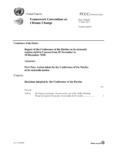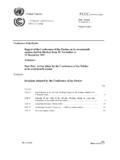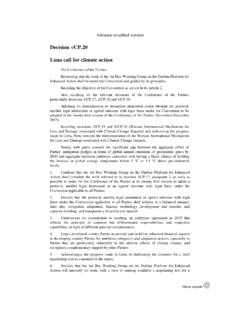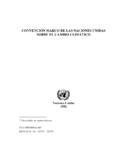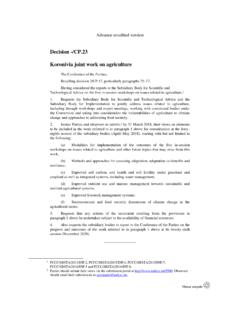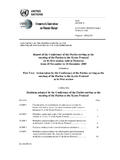Transcription of FORESTS - Climate Change, Biodiversity and Land …
1 FORESTS . Climate change , Biodiversity and land degradation Joint Liaison Group of the Rio Conventions Photos courtesy of C. Buddle FORESTS cover approximately 30% of the Earth's land surface and provide critical ecosystem goods and services, including food, fodder, water, shelter, nutrient cycling, and cultural and recreational value. FORESTS also store carbon, provide habitat for a wide range of species and help alleviate land degradation and desertification. The Rio Conventions: the United Nations Framework Convention on Climate change (UNFCCC), the United Nations Convention on Biological Diversity (CBD) and the United Nations Convention to Combat Desertification (UNCCD), all acknowledge the important contribution of FORESTS to the achievement of their respective goals and objectives and are working together to enhance synergies in this area.
2 Global forest cover was just under 4 billion ha in 2005, 36% of which were classified as primary FORESTS FORESTS provide approximately billion people with food, medicines, fuel and other basic necessities Over two thirds of known land -based species live in FORESTS Approximately 8000 tree species, or 9% of the total number of tree species worldwide, are currently under threat of extinction The latest deforestation rates are estimated around 13 million hectares per year: a net loss of about million hectares per year for 2000 2005.
3 Deforestation is estimated to have been the cause of 20% of annual greenhouse gas emissions in the 1990s (FAO, 2005; Millenium Ecosystem Assessment, 2005; IPPC, Fourth Assessment Report, 2007).. Collaboration between the Rio Conventions and their secretariats The Joint Liaison Group (JLG) between the secretariats of the CBD, the UNCCD and the UNFCCC was established with the aim of enhancing coordination between the three conventions including cooperation concerning the links between Climate change , Biodiversity and desertification.
4 All three secretariats currently collaborate through information sharing and outreach, including the development of common messages. Further collaboration focuses on ensuring that Parties are kept informed of relevant initiatives in other conventions. To date, the JLG has identified several options for cooperation at the level of Convention bodies and secretariats and has been called on to support collaboration among national focal points. The JLG continues to consider activities that could be implemented at the level of the secretariats during the period 2007-2008.
5 This information note is the first step to enhance collaboration in the area of links between Climate change , FORESTS , combating desertification, Biodiversity conservation and sustainable use. forest related partnerships of the Rio Conventions The secretariats of the Rio Conventions also collaborate with other international organizations and non- governmental organizations with substantial programmes on FORESTS . All three secretariats are members of the Collaborative Partnership on FORESTS (CPF), which promotes the sustainable management and conservation of all types of FORESTS and strengthens long-term political commitments to this end.
6 In addition, the three secretariats are members of a special CPF Task Force working towards streamlining forest -related reporting and minimizing the reporting burden on countries. The secretariats also collaborate closely with the secretariat of the United Nations Forum on FORESTS (UNFF). and are currently exploring options for enhanced collaboration with this body, particularly in light of the recent adoption, at the seventh session of the UNFF, of the non-legally bnding instrument on all types of FORESTS and the new multi-year programme of work for 2007-2015.
7 In all these interactions, the secretariats advocate the strengthening of capacities of countries to combat threats to forest Biodiversity , to combat desertification, land degradation and deforestation (particularly in countries with low forest cover); and to reduce emissions from land use and land -use change activities. Photo courtesy of C. Buddle . The Importance of forest Ecosystems Climate change mitigation and adaptation FORESTS present a significant global carbon stock. Global forest vegetation stores 283 Gt of carbon in its biomass, 38 Gt in dead wood and 317 Gt in soils (top 30 cm) and litter.
8 The total carbon content of forest ecosystems has been estimated at 638 Gt for 2005, which is more than the amount of carbon in the entire atmosphere. This standing carbon is combined with a gross terrestrial uptake of carbon, which was estimated at Gt a year, a good deal of which is sequestration by FORESTS . FORESTS also have a potentially significant role to play in Climate change adaptation planning through maintaining ecosystem services and providing livelihood options. Photo courtesy of K. Muldoon Conservation and sustainable use of Biodiversity FORESTS are one of the most Biodiversity .
9 Rich habitats on Earth. For example, approximately 60% of all higher plant species are based in rainforests. Furthermore, in the Amazon basin alone, more than 1,300 species of forest plants are used for medicinal or cultural purposes. This is one example of the vast array of forest Biodiversity that has important value as a source of food, medicine, fodder, and raw material. As such, the achievement of the Millennium Development Goals is Photo courtesy of inextricably linked to forest Biodiversity . Photo courtesy of J.
10 Kern A. Shah / Combating land degradation and desertification Deforestation and desertification adversely affect agricultural productivity, the health of humans as well as of livestock, and economic activities such as eco- tourism. FORESTS and tree cover combat land degradation and desertification by stabilizing soils, reducing water and wind erosion and maintaining nutrient cycling in soils. Sustainable use of goods and services from forest ecosystems and the development of agroforestry systems can, therefore, contribute to poverty reduction, making the rural poor less vulnerable to the impacts of land degradation .



